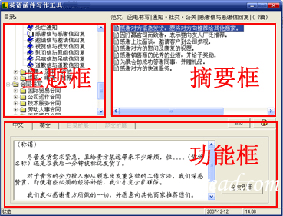英文法律词典 P-65
|
PLAT. A map of a piece of land, in which are marked the courses and disstances of the different lines, and the quantity of land it contains. 2. Such a plat;nay be given in evidence in ascertaining the position of the land, and what is included, and may serve to settle the figure of a survey, and correct mistakes. 5 Monr. 160. See 17 Mass. 211; 5 Greenl. 219; 7 Greenl, 61; 4 Wheat. 444; 14 Mass. 149. PLEA, chancery practice. "A plea," says Lord Bacon, speaking of proceedings in courts of equity, "is a foreign matter to discharge or stay the suit." Ord. Chan. (ed. Beam.) p. 26. Lord Redesdale defines it to be " a special answer showing or relying upon one or more thisgs as a cause why the suit should be either dismissed, delayed or barred." Mitf. Tr. Ch. 177; see Coop. Eq. Pl. 223; Beames' Pl. Eq. 1. A plea is a special answer to a bill, and differs in this from an answer in the common form, as it demands the judgment of the court in the first instance, whether the matter urged by it does not debar the plaintiff from his title to that answer which the bill requires. 2 Sch. & Lef. 721. 2. Pleas are of three sorts: 1. To the jurisdiction of the court. 2. To the person of the plaintiff. 3. In bar of the plaintiff's suit. Blake's Ch. Pr. 112. See, generally, Beames' Elem. of Pleas in Eq.; Mitf. Tr. Cha. oh. 2, s. 2, pt. 2; Coop. Eq. Pl. ch. 5; 2 Madd. Ch. Pr. 296 to 331; Blake's Ch. Pr. 112 to 114; Bouv. Inst. Index, h. t. PLEA, practice. The defendant's answer by matter of fact, to the plaintiff's declaration. 2. It is distinguished from a demurrer, which opposes matter of law to the declaration. Steph. Pl. 62. 3. Pleas are divided into plea dilatory and peremptory; and this is the most general division to which they are subject. 4. Subordinate to this is another division; they are either to the jurisdiction of the court, in suspension of the action; in abatement of the writ; or, in bar of the action; the first three of which belong to the dilatory class, the last is of the peremptory kind. Steph. Pl. 63; 1 Chit. Pl. 425; Lawes, Pl. 36. 5. The law has prescribed and settled the order of pleading, which the defendant is to pursue, to wit; 1st. To the jurisdiction of the court. 2d. To the disability, &c. of the person. 1st. Of thepla'intiff. 2d. Of the defendant. 3d. To the count or declaration. 4th. To the writ. 1st. To the form of the writ; first, Matter apparent on the face of it, secondly, Matter dehors. 2d. To the action of the writ. 5th. To the action itself in bar. 6. This is said to be the natural order of pleading, because each subsequent, plea admits that there is no foundation for the former. Such is the English law. 1 Ch. Plead. 425. The rule is different with regard to the plea of jurisdiction in the courts of the United States and those of Pennsylvania. 1. Binn. 138; ld. 219; 2 Dall. 368; 3 Dall. 19; 10 S. & R. 229. 7. - 2. Plea, in its ancient sense, means suit or action, and it is sometimes still used in that sense; for example, A B was summoned to answer C D of a plea that he render, &c. Steph. Pl. 38, 39, u. 9; Warr. Law Studies, 272, note n. 8. - 3. This variable word, to plead, has still another and more popular use, importing forensic argument in a cause, but it is not so employed by the profession. Steph. Pl. App. note 1. 9. There are various sorts of pleas, the principal of which are given below. 10. Plea in abatement, is when, for any default, the defendant prays that the writ or plaint do abate, that is, cease against him for that time. Com. Dig. Abatement, B. 11. Hence it may be observed, 1st. That the defendant may plead in Abatement for faults apparent on the writ or plaint itself, or for such as are shown dehors, or out of the writ or plaint. 2d. That a plea in, abatement is never perpetual, but only a temporary plea, in form at least, and if the cause revived, the plaintiff may sue again. 12. If the defendant plead a plea in abatement, in his plea, he ought generally to give a better writ to the plaintiff, that is, show him what other and better writ can be adopted; Com. Dig. Abatement, I 1; but if the plea go to the matter and substance of the writ, &c., he need not give the plaintiff another writ. Nor need he do so when the plea avoids the whole cause of the action. Id. I 2. 13. Pleas in abatement are divided into those relating, first, to the disability of the plaintiff or defendant; secondly, to the count or declaration; thirdly, to the writ. 1 Chit. Pl. 435. 14. - 1. Plea in abatement to the person of the plaintiff. Pleas of this kind are either that the plaintiff is not in existence, being only a fictitious person, or dead; or else, that being in existence, he is under some disability to bring or maintain the action, as by being an alien enemy; Com. Dig. Abatement, E 4 Bac. Abr. Abatement, B 3; 1 Chit. Pl. 436; or the plaintiff is a married woman, and she sues alone. See 3 T. R. 631; 6 T. R. 265. 15. Plea in abatement to the person of the defendant. These pleas are coverture, and, in the English law, infancy, when the parol shall demur. When a feme covert is sued, and the objection is merely that the hushand ought to have been sued jointly with her; as when, since entering into the contract, or committing the tort, she has married; she must, when sued alone, plead her coverture in abatement, and aver that her hushand is living. 3 T. R. 627; 1 Chit. Pl. 437 , 8. 16. - 2. Plea in abatement to the count. Pleas of this kind are for some uncertainty, repugnancy, or want of form, not appearing on the face of the writ itself, but apparent from the recital of it in the declaration only; or else for some variance between the writ and declaration. But it was always necessary to obtain oyer of the writ before the pleading of these pleas; and since oyer cannot now be had of the original writ for the purpose of pleading them, it seems that they can no longer be pleaded. See Oyer. 17. Plea in abatement to the form of the writ. Such pleas are for some apparent uncertainty, repugnancy, or want of form, variance from the record, specialty, &c., mentioned therein, or misnomer of the plaintiff or defendant. Lawes' Civ. Pl. 106; 1 Chit. Pl. 440. 18. Plea in abatement to the action of the writ. Pleas of this kind are pleaded when the action is misconceived, or was prematurely commenced before the cause of action arose; or when there is another action depending for the same cause. Tidd's Pr. 579. But as these matters are ground for demurrer or nonsuit, it is now very unusual to plead them in abatement. See 2 Saund. 210, a. 19. Plea in avoidance, is one which confesses the matters contained in the declaration, and avoids the effect of them, by some new matter which shows that the plaintiff is not entitled to maintain his action. For example, the plea may admit the contract declared upon, and show that it was void or voidable, because of the inability of one of the parties to make it, on account of coverture, infancy, or the like. Lawes, Pl. 122. 20. Plea in bar, is one that denies that the plaintiff has any cause of action. 1 Ch. Pl. 459 Co. Litt. 303 b; 6 Co. 7. Or it is one which shows some ground for barring or defeating the action; and makes prayer to that effect, Steph. Pl. 70; Britton, 92. See Bar. #p#副标题#e# 21. A plea in bar is, therefore, distinguished from all pleas of the dilatory class, as impugning the right of the action altogether, instead of merely tending to divert the proceedings to another jurisdiction, or suspend them, or abate the particular writ. It is in short a substantial and conclusive answer to the action. It follows, from this property, that in general, it must either deny all, or some essential part of the averments of fact in the declaration; or, admitting them to be true, allege new facts, which obviate and repel their legal effect. In the first case the defendant is said, in the language of pleading, to traverse the matter of the declaration; in the latter, to confess and avoid it. Pleas in bar are consequently divided into pleas by way of traverse, and pleas by way of confession and avoidance. Steph. Pl. 70, 71. 22. Pleas in bar are, also divided into general or special. General pleas in bar deny or take issue either upon the whole or part of the declaration, or contain some new matter which is relied upon by the defendant in his defence. Lawes Pl. 110. 23. Special pleas in bar a re very various, according to the circumstances of the defendant's case; as, in personal actions, the defendant may plead any special matter in denial, avoidance, discharge, excuse, or justification of the matter alleged in the declaration, which destroys or bars the plaintiff's action; or he may plead any matter which estops, or precludes him from averring or insisting on any matter relied upon by the plaintiff in his declaration. The latter sort of pleas are called pleas in estoppel. In real actions, the tenant may plead any matter which destroys and bars the demandant's title; as, a general release. Id. 115, 116. 24. The general qualities of a plea in bar are, 1. That it be adapted to the nature and form of the action, and also conformable to the count. Co. Litt. 303, a 285, b; Bac. Abr. Pleas, I; 1 Roll. Rep. 216. 2. That it answers all it assumes to answer, and no more. Co. Litt. 303 a; Com. Dig. Pleader, E 1, 36; 1 Saund. 28, n. 1, 2, 3; 2 Bos. & Pull. 427; 3 Bos. & Pull. 174. 3. In the case of a special plea, that it confess and admit the fact. 3 T. R. 298; 1 Salk. 394; Carth. 380; 1 Saund. 28, n. and 14 u. 3 10 Johns. R. 289. 4. That it be single. Co. Litt. 304; Bac. Ab. Pleas, 2 Saund. K, 1, 2; Com Dig. Plead. E 2; 49, 50; Plowd. Com. 140, d. 5. That it be certain. Com. Dig. Pleader, E 5, 7, 8, 9, 10, 11; C 41; this Dict. Certainty; Pleading. 6. It must be direct, positive, and not argumentative. See 6 Cranch, 126; 9 Johns. It. 313. 7. It must be capable of trial. 8. It must be true and capable of proof. See Plea, sham. 25. The parts of a plea in bar may be considered with reference to, 1. The title of the court in which it is pleaded. 2. The title of the term. 3. The names of the parties in the margin. These, however, do not constitute any part of the plea. The surnames only are usually inserted, and that of the defendant precedes the plaintiff's; as, " Roeats. Doe." 4. The commencement which includes the statement of, 1. The name of the defendant; 2. The appearance; 3. The defence; see Defence; 4. The actio non; see dctio non. 5. The body, which may contain, 1. The inducement; 2. The protestation; 3. Ground of defence 4. Qua est eadem; 5. The traverse. 6. The conclusion. 26. Dilatory pleas are such as delay the plaintiff's remedy, by questioning, not the cause of action, but the propriety of the suit, or the mode in which the remedy is sought. 27. Dilatory pleas are divided by Sir William Blackstone, into three kinds: 1. Pleas to the jurisdiction of the court; as, that the cause of action arose out of the limits of the jurisdiction of the court, when the action is local. 2. Pleas to the disability of the plaintiff, or, as they are usually termed, to' the person of the plaintiff; as, that he is an alien enemy. 3. Pleas in abatement of the writ, or count; these are founded upon some defect or mistake, either in the writ itself; as, that the defendant is misnamed in it, or the like; or in the mode in which the count pursues it; as, that there is some variance or repugnancy between the count and writ; in which case, the fault in the count furnishes a cause for abating the writ. 2 Bl. Com. 301 Com. Dig. Abatement, G 1, 8; Id. Pleader, C 14, 15; Bac. Ab. Pleas, F 7. 28. All dilatory pleas are sometimes called pleas in abatement, as contradistinguished to pleas to the action; this is perhaps not strictly proper, because, though all pleas in abatement are dilatory pleas, yet all dilatory pleas are not pleas in abatement. Gould on Pl. ch. 2, §35; vide 1 Chit. PI, ch. 6; Bac. Ab. Abatement, 0; 1 Mass 358; 1 John. Cas. 101. 2. A plea in discharge, as distinguish ed from a plea in avoidance, is one which admits the demand, and instead of avoiding the payment or satisfaction of it, shows that it has been discharged by some matter of fact. Such are pleas of payment, release, and the like. 30. A plea in excuse, is one which admits the demand or complaint stated in the declaration, but excuses the non-compliance of the plaintiff's claim, or the commission of the act of which he complains, on account of the defendant having done all in his power to satisfy the former, or not having teen the culpable author of the latter. A plea of tender is an example of the former, and a plea of son assault demesne, an instance of the latter. 31. A foreign plea is one which takes the cause out of the court where it is pleaded, by showing a want of jurisdiction in that court. 2 Lill. Pr. Beg. 374; Carth. 402. See the form of the plea in Lill. Ent. 475. 32. A plea of justification is one in which the defendant professes purpo sely to have done the acts which are the subject of the plaiutiff's suit, in order to exercise that right which he considers he might in point of law exercise, and in the exercise of which he conceives himself not merely excused, but justified. 33. A plea puis darrein continuance. Under the ancient law, there were continuances, i. e. adjournments of the proceedings for certain purposes, from one day or one term to another; and, in such cases, there was an entry made on the record, expressing the ground of the adjournment, and appointing the parties to reappear at a given day. 34. In the interval between such continuance and the day appointed, the parties were of course out of court, and consequently not in a situation to plead. But it sometimes happened, that after a plea had been pleaded, and while the parties were out of court, in consequence of such continuance, a new matter of defence arose, which did not exist, and which the defendant had consequently no opportunity to plead, before the last continuance. This new defence he was therefore entitled, at the day given for his reappearance, to plead as a matter that had happened after the last continuance, puis darrein continuance. In the same cases that occasioned a continuance in the ancient common Iaw, but in no other, a continuance shall take place. At the time indeed, when the pleadings are filed and delivered, no record exists, and there is, therefore, no entry at that time, made on the record, of the award of a continuance; but the parties are, from the day when, by the ancient practice, a continuance would have been entered, supposed to be out of court, and the pleading is suspended, till the day arrives to which, by the ancient, practice, the continuance would extend. At that day, the defendant is entitled, if any new matter of defence has arisen in the interval, to plead it according to the ancient plan, puis darrein continuance. 35. A plea puis darrein continuance is not a departure from, but is a waiver of the first plea, and is always headed by way of substitution for it, on which no proceeding is afterwards had. 1 Salk. 178; 2 Stran. 1195 Hob. 81; 4 Serg. & Rawle, 239. Great certainty is requisite in pleas of this description. Doct. Pl. 297; Yelv. 141; Cro. Jac. 261; Freem. 112; 2 Lutw. 1143; 2 Salk. 519; 2 Wils. 139; Co. Entr. 517 b. It is not sufficient to say generally that after the last continuance such a thing happened, but the day of the continuance must be shown, and also the time and place must be alleged where the matter of defence arose. Id. ibid.; Bull. N. P. 309. 36. Pleas puis darrein continuance are either in bar or abatement; Com. Dig. Abatement, I 24; and are followed, like other pleas, by a replication and other pleadings, till issue is attained upon them such pleas must be verified on oath before they are allowed. 2 Smith's R. 396; Freem. 352; 1 Strange, 493. 37. A sham plea is one which is known to the pleader to be false, and is entered for the purpose of delay. There are certain pleas of this kind, which, in consequence of their having been long and frequently used in practice, have obtained toleration from the courts; and, though discouraged, are tacitly allowed; as, for example, the common plea of judgment recovered, that is, that judgment has been already recovered by the plaintiff, for the same cause of action. Steph. on Pleading, 444, 445; 1 Chit. Pl. 505, 506. 38. Plea in suspension of the action. Such a plea is one which shows some ground for not proceeding in the suit at the present period, and prays that the pleading may be stayed, until that ground be removed. The number of these pleas is small. Among them is that which is founded on the nonage of the parties, and termed parol demurrer. Stephen on Pleading, 64. See, generally, Bac. Abr. Pleas, Q; Com. Dig. Abatement, I 24, 34; Doct, Pl. 297; Bull. N. P. 309; Lawes Civ. Pl. 173; 1 Chit. Pl. 634,; Steph. Pl. 81; Bouv. Inst. Index, h. t. |








